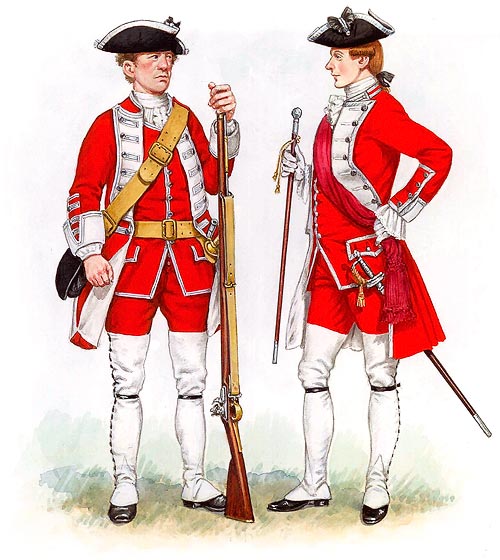The Queen's Royal Surrey Regiment
The Territorial Army
The Origins
The Territorial Army, or Territorial Force as it was then known, came into being on April 1st 1908 as one of the results of the passing of the Territorial and Reserve Forces Act 1907. This Act revised and consolidated the provisions and conditions of volunteer and part-time military organisations then in being, some of whose origins were founded deep in history.
 |
| Officer and Private, Surrey Militia 1759-63. (Click to enlarge) |
In this country in peace-time there has always been a certain amount of resistance to the maintenance of a large scale standing Army and even more resistance to financing it. The part-time “man at arms” has therefore always seemed a reasonable compromise. In Saxon times there wasn’t even a Regular Army in existence so an obligation fell on all “free-men” of the country to make provision for its defence if need should arise. Levies for the defence of different areas were imposed, resulting in the formation of a militia or Fyrd as it was then known. Although the militia was part-time it was a force which locally raised was under legal obligations and forms of impressment. (The Saxons had a rather similar system of policing, whereby the people were divided into groups of ten families, known as tythings, and were under a distinct obligation to maintain law and order among themselves - the basis of what is now known as “community policing”).
The Normans, on their arrival in the country, tended to rely more on professional soldiery and the system lapsed but did not become extinct. Developing from the early bowmen they later became equipped with, and trained in the use of, firearms and gained recognition as a support force for the defence of the country in time of need, particularly during the Napoleonic wars when invasion was seriously expected and contemplated.
After Waterloo the militia faded into obscurity but made a comeback as a volunteer force in 1852. Largely officered by the local squirearchy it developed a prestigious image and in many cases formed a mode of entry into the Regular Army and the obtaining of regular commissions. Royal recognition and approval was forthcoming in 1904 when King Edward VII instituted the Militia Long Service and Good Conduct Medal. It was to be awarded to all noncommissioned officers and men of good character who completed eighteen years service with fifteen annual trainings. Hanging from a light blue ribbon it had the King’s head on the obverse while the reverse bore the words “Militia. For Long Service and Good Conduct”.
The Militia (now with a capital ‘M’) ceased existence in 1908 with the formation of the new Territorial Force but the term, though not the form, was revived for a short time in 1939 when the Government introduced conscription. The early conscripts were called Militiamen but the term lapsed with the outbreak of war and was never revived. Post-war conscripts were known as National Servicemen.
Of lesser ancient ancestry than the Militia, but equally important as a part-time defence force were the volunteers, some of whom can trace their origins far back into history. The famed and distinctive Honourable Artillery Company has a charter granted by Henry VIII in 1537 to its parent body the “Fraternitie or Guylde of St George: Maisters and Rulars of the Science of Artillerie...” The Royal Monmouthshire Royal Engineers (Militia) can trace their volunteer and Militia background for 400 years.
Many of the volunteer units emerged from the Militia but then developed their own identities, traditions, styles and uniforms-the latter often being of splendid and gorgeous proportions and paid for by the volunteers themselves. Such was their enthusiasm that they often paid also for their own camps, ranges and drilling arrangements. Organisation was generally on a county, district or urban basis although some units were formed within existing comparable civilian establishments such as the Civil Service, the Inns of Court, the Post Office, the Bankers and the Railways. (There was even one suggestion of forming Rifle Companies from the Police but this did not find favour-being against the principle of an unarmed police force).
Not confining themselves to foot soldiers, the volunteers also formed mounted units to become known as Yeomanry Voluntary Cavalry or, more shortly, Yeomanry. These developed a certain amount of unpopularity at one time through being used as law enforcement agencies, sometimes in connection with political matters. A notorious occasion was that of the Peterloo Massacre at Manchester in 1819 when Hussars and Yeomanry charged a crowd listening to a famous orator, William Hunt. Excessive casualties brought this type of action into disfavour and eventually led to the formation of civilian police forces, beginning with the establishment of the Metropolitan Police Force in 1829.
Of supreme importance at the time of the Napoleonic Wars, the Volunteers and Yeomanry, like other military organisations, tended to lapse thereafter but came into their own again at the time of the South African War when, not only on home service, they became available voluntarily for service overseas. (There was a precedent for this. The Post Office Volunteers had sent a detachment to Egypt in 1882).
Over 18,000 volunteers went to the South African War in various roles, most notably being the City Imperial Volunteers and the Imperial Yeomanry-the latter being formed largely from existing Yeomanry Regiments.
The South African War demonstrated many military deficiencies, one of them being the need to reorganise and consolidate the various auxiliary and reserve forces then in existence. The result was that under the impetus and guidance of Lord Haldane, Secretary of State for War, the Territorial and Reserve Forces Act 1907 was passed, leading to the formation of the Territorial Force in 1908.
Related
